News and Site Updates Archive 2010/03/31
I’d like to agree with you, but then we’d both be wrong.
|
31 Mar '10 - |
 |
Galaxy SMM J2135-0102 was discovered with the APEX Telescope. This galaxy, about 10 billion light-years distant, was actively
star-forming when the Universe was only 3 billion years old. It is gravitationally lensed by a factor of 32 via a foreground galaxy cluster. Due to this, it has apparent brightness enough to
be one of the brightest galaxies known and an ideal study of the processes of distant (early) star-formation. Star-forming regions are 100 times bigger, and 10 million times more luminous,
than the dense cores of giant molecular clouds. These star factories are similar in size to those in the Milky Way but 100 times more luminous, suggesting star formation in the early universe
was more vigorous than what is seen locally. At left is what turns out to be merely an artist’s impression of this galaxy, showing large bright clouds a few hundred light-years in
size. Note that at right is the actual telescope image. How fanciful is the artist's impression? Since I was captured by the unusual form and density of this galaxy (thinking I
was seeing a photograph), I have to say that I was deeply disappointed. (In astronomy, I feel it's important to clearly distinguish the real from the fanciful.) Credit: ESO / M
Kornmesser |
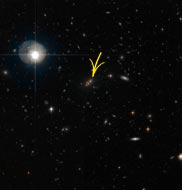 |
|
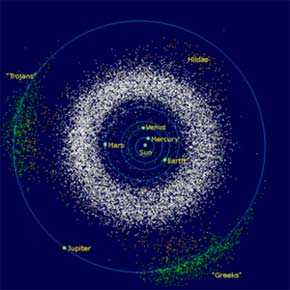 |
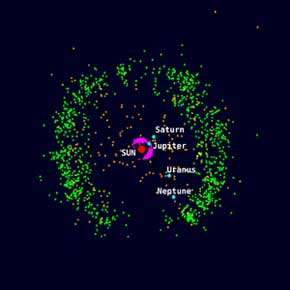 |
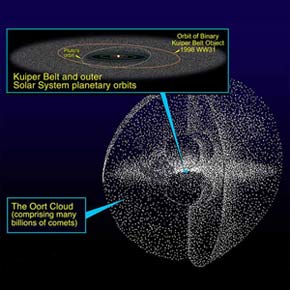 |
|
LEFT: The asteroid belt is the region of the Solar System located roughly
between the orbits of Mars and Jupiter. It is occupied by numerous irregularly-shaped bodies called asteroids or minor planets; 3 of these have diameters of more than 400 kilometres,
while Ceres, its only dwarf planet, is about 950 kilometres. Though the photo looks dense with debris, bodies are actually so thinly distributed that multiple unmanned spacecraft
traversed it without incident. Nonetheless, collisions between large asteroids do occur. Bodies have too much orbital energy to accrete into planets; collisions among them are
violent. Instead of sticking together, they shatter when they collide. Some resultant debris forms meteoroids that enter Earth's atmosphere. More than 99.8% of the 30,000
meteorites found on Earth to date are believed to have originated in the asteroid belt - one of them likely triggered extinction of the dinosaurs.
MIDDLE: The Kuiper belt is a region of the Solar System beyond the planets
similar to the asteroid belt, although it is far larger — 20 times as wide and 20 to 200 times as massive. Kuiper belt objects are composed largely of frozen volatiles (termed
"ices"), such as methane, ammonia and water. It is home to at least 3 dwarf planets – Pluto, Haumea and Makemake. The number of known Kuiper belt objects (KBOs) has increased
to over 1,000 and more than 70,000 KBOs over 100 kilometres (62 miles) in diameter are believed to exist. Since the year 2000, a number of KBOs with diameters of between 500 and 1,200
kilometres (746 miles) have been discovered. The Kuiper belt should not be confused with the hypothesised Oort cloud, which is 1,000 times more distant.
RIGHT: The Oort cloud is a hypothesised spherical cloud of comets which may lie
roughly 50,000 AU, or nearly a light-year, from the sun. The outer extent of the Oort cloud defines the gravitational boundary of our Solar System. Objects in the Oort cloud
are largely composed of ices such as water, ammonia, and methane. The outer Oort cloud is only loosely bound to the Solar System and thus is easily affected by the gravitational pull
both of passing stars and of the Milky Way Galaxy itself. These forces occasionally dislodge comets from their orbits within the cloud and send them towards the inner Solar System.
Gliese 710 is a variable orange dwarf star in the constellation Serpens Cauda. It is
currently about 63 light years from Earth, but it will approach within 1.1 light years (70,000 AU) from Earth within 1.4 million years, causing gravitational perturbation of our Solar
System - perhaps enough to cause the Oort cloud to send showers of comets our way, causing one or more impacts. |
|
 |
Philosopher of Physics Dean Rickles: "Either existence is contingent (it depends on other things) or
it's necessary. If contingent, then there's no complete coherent account of existence. If it's necessary, then we need a necessary structure to ground this fact. Mathematical
structures might work. If reality is mathematical then it must exist. Reality IS mathematical (as evidenced by its effectiveness in the sciences), therefore, there IS
existence. This is not a case of logic 'causing' existence, or bringing existence into being 'out of nothing'. Mathematical structures are timeless. If mathematical structures are
the only reason that can be found for existence to be, then physical reality (or just reality) has to be mathematical. In other words, the universe is mathematical because there is
existence, and the only reason for there to be existence is that there are mathematical truths." From Philosopher of Physics Gordon McCabe: "Martin Heidegger claimed that this is the most
important question in philosophy. 'Why is there something physical rather than nothing physical?' The implicit assumption which underlies this question is that the existence of the
physical universe is contingent. If one rejects this assumption, then one possible answer to the question is that the physical universe exists necessarily. Mathematical
structures exist necessarily because mathematical existence is merely absence from contradiction, and modern theoretical physics represents the physical universe as a mathematical structure, hence
the physical universe exists necessarily as a special case of mathematical existence." Rickles again: "The mathematical universe is safe from Godel’s theorem. We must distinguish
between truth and provability." (Philosophers, you see, are not lawyers.) |
|
 |
Given our technological expertise for virtual presence – an expertise that is advancing rapidly –
exploration does not need to be the prime justification for human space flight anymore. The Augustine committee has shown the courage to challenge the traditional view of astronauts as
explorers in its "Flexible Path" proposal, a plan to send humans at first into deep space, perhaps doing surveillance work on deep gravity wells, while rovers conduct work on the ground. Critics
have derisively called it the "Look But Don’t Touch" option, one that will extend scientific exploration even if it does not include any "Neil Armstrong moments." Yet perhaps 2010 is the year
when we challenge the meaning of "exploration." Via Time to Eat the Dogs. |
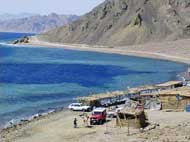 |
Dahib, Egypt: "To swim in the Blue Hole is to hover at the top of a giant underwater atrium, the walls of which are alive
and moving with colour, a column with no bottom, no reference points except void and sky. It is unnerving and disorienting, an effect that becomes more pronounced the further I swim from shore
toward the outer edge of the reef. I feel as if I'm swimming through an electric current. My limbs feel twitchy and my heart races; I feel exhilarated and ebullient and, strangely, like
I'm about to die." The Blue Hole, (located on the Red Sea), is probably Egypt's most infamous diving spot. The hole is a
shaft starting a metre below the surface of the sea. The dark zone is the place - it goes 80 metres straight down. The main trip for experienced divers is to plunge to a depth of 60 metres,
then pass through a tunnel to the outer edge of the reef before returning to surface. People die here almost every year, mainly from nitrogen narcosis - apparently it's too enticing to dive alone
(this should only be done after years of training). But the Blue Hole is not only for divers, it is chillingly fascinating for snorkelers as well. The corals are colourful, fish abundant,
and you can tickle your nerves by swimming along the edge of this hole with no visible bottom. |
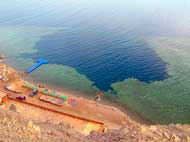 |
 |
Intense lightning bolts that regularly illuminated the skies over Venezuela's Lake Maracaibo have disappeared entirely for the past 2 months. Catatumbo lightning has occurred at least as far back as the beginning of European colonisation where the Catatumbo River empties into the
lake. Not a single bolt has struck the area since late January, which can receive up to 20,000 bolts in a single night. The discharges normally occur approximately 160 nights per year and
around 10 hours per day. Meteorologists point to the current El Niño phenomenon for both the lack of lightning and for the severe drought that has plagued Venezuela in recent months. It's
believed the lightning is normally triggered by ionised gas, such as methane, rising high into the atmosphere from the petroleum-rich lake and marshland, gathering an intense electrical charge during
the ascent. The nearly-continuous discharges of lightning that had occurred over Maracaibo were believed to be the world's largest single generators of tropospheric ozone. When the
lightning will return and the long-term impact of its disappearance are unknown. |

This is sunset over Island Bay in Wellington taken by my son, Wolf with his cellphone.
The body of water is Cook Strait and you can see the South Island in the distance. Move to NZ! You won't regret it. |
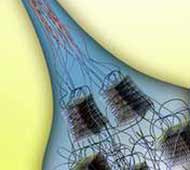 |
Scientists at MIT have found a way of transforming the molecular structure of
polythene - the stuff that you make plastic bags with - to turn it into an effective heat conductor and electrical insulator. What’s more, the material only conducts heat in one direction,
making it an ideal material for cooling silicon computer chips. The polymer molecules were lined up all in the same direction, rather than forming a chaotic tangled mass, by being slowly drawn as
polyethylene fibres out of a solution, using the finely controllable cantilever of an atomic force microscope. At this time, it is not scalable to a macro level, but the current goal is to be able
to produce this in large sheets. On the other hand, Japanese researchers have developed a new diode made of two types
of perovskite cobalt oxides that, glued together, only allow a heat current to pass in one direction but not the other. Such a device can create heat sinks to keep microchips running cool and maybe
one day control heat currents to create a new type of information processing with thermal transistors, thermal logic gates, and thermal memory. This could also harness waste heat from electronic
devices to supplement electrical power. |
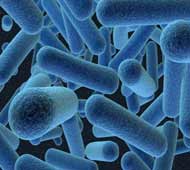 |
The human body is, to some extent, just a luxury cruise liner for
microbes. They board the SS Homo sapiens when we’re born and settle into their assigned quarters – skin, tongue, nostrils, throat, stomach, genitals, gut – and we then carry them
wherever we go. Some microbes de-board when we shed our skin or use the toilet; others board at new ports when we shake someone’s hand or down a spoonful of yogurt. Just as on a luxury
cruise liner, our passengers eat well. They feed on food we eat, or on the compounds we produce. While the biggest luxury liners may carry a few thousand people, we can handle many more
passengers. Although the total mass of our microbes is just a few pounds, the tiny size of their cells means that we each carry about 100 trillion microbes – outnumbering our own cells by more
than 10 to 1. Our microbial passengers may actually help out the cruise liner’s crew - they can close up ecological spaces in our bodies so that invading pathogens can’t get a solid
foothold. Some species in our gut break down our food in ways that we can’t, and synthesise certain vitamins and other compounds beyond our biochemistry. The genes that the microbes
carry – millions of them – expand our biochemical powers enormously. Every time we take a dose of antibiotics, the microbial balance can change dramatically. And as the diversity of our
microbes changes, so does their function. The wrong microbes can even make you fat... |
 |
Scandinavian scientists have discovered that a species of tree defends itself from herbivore attack by using chemicals emitted by
neighbouring plants. Mountain birch trees adsorb chemical compounds from neighbouring marsh tea plants, Rhododendron tomentosum, in a unique "defence by neighbour strategy", in turn
emitting the chemical, thus warding off animals such as feeding moths. Plant emissions can have several rôles, including the attraction or deterrence of herbivores. Some cause an indirect
defence by attracting a herbivorous natural enemy, but it is extraordinary for one plant to benefit directly from another plant's emissions. Results show that interactions between species through
emissions are a good example of the ecological effects that need to be considered more from a plant community than from an individual plant point of view. Passive adsorption of compounds by a
neighbouring plant might be an important, but understudied, way for these compounds to act in a natural environment and could be an important factor in plant fitness and species distribution. |
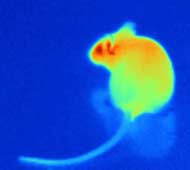 |
Allyl isothiocyanate is the organosulfur compound responsible for the pungent taste of mustard, horseradish, and
wasabi. It is slightly soluble in water, but well soluble in most organic solvents. It comes from the seeds of black mustard (Brassica nigra) or brown Indian mustard (Brassica
juncea). When these mustard seeds are broken, the enzyme myrosinase is released and acts on a glucosinolate known as sinigrin to give allyl isothiocyanate, which serves the plant as a
defence
against herbivores. Since it is harmful to the plant itself, it is stored in the harmless form of the glucosinolate, separate from the myrosinase enzyme. When an animal chews the plant,
allyl isothiocyanate is created and released, repelling the animal. Synthetic allyl isothiocyanate is used as an insecticide, bacteriocide, and nematocide. Genes that make mustard hot and spicy on human tongues also let snakes "see" heat, explaining the remarkable ability of some species to
strike prey in total darkness. Until now, scientists knew that snakes’ heat perception involved the pit organ, a cavity found between the eyes and nostrils of boa constrictors, pythons and pit
vipers. These species can hunt if blindfolded, but cover their pit organ and they can’t. Beyond that, however, the snakes’ sixth sense was a mystery. When they measured gene activity
in nerve cells that run from pit organs to snake brains, researchers found that a gene called TRPA1 was about 400 times higher than in other snake tissues. In humans, TRPA1 produces proteins that
let people detect chemical irritation and temperature difference, producing the distinctive sensation of mustard and peppers. As for what a mouse slathered in mustard or horseradish would taste
like to a snake, they do not speculate. |

Nixie tubes from 1954. Before LED’s and digital readouts, Nixie
tubes were the only way to display digital data.
In the 1980s, I made backups of
the hard drive of my PC onto 5¼-inch floppy disks. I thought that because digital copies were "perfect" and I could make perfect copies of perfect copies, I couldn’t lose my data
except by accident. I believed that until years later, when I tried to restore my backup of 70 floppy disks onto a new PC. To my dismay, I discovered that I had lost the floppy disk
containing the backup program itself, and thus could not restore my data. Some investigation revealed that the company that made the software had long since gone out of business. Requests
on electronic bulletin board systems and searches on Usenet turned up nothing helpful. Although all the data on the disks may have survived, they were useless because of a proprietary encoding
scheme used by the backup program. Over the course of the 20th century and into the 21st, an increasing proportion of information we create and use has been in the form of digital
data. Many (most?) of us have given up writing messages on paper, instead adopting electronic formats; we've exchanged film-based photographic cameras for digital ones. Will those
precious family photographs and letters (email) created today survive for future generations, or will they suffer a sad fate similar to my backup floppy disks? It seems unavoidable that most of
the data in our future will be digital, so it behooves us to understand how to manage and preserve it so that we can avoid what some have called the "digital dark age." This is the idea — or
fear! — that if we cannot learn to explicitly save (and re-save in newer formats) our digital data, we'll lose it and, with that loss will go the record that future generations might use to remember
and understand us. Via the New Shelton wet/dry.
When early-American pioneers headed west in covered wagons, many lost everything that tied them to the past. It may be sad, but if won't be fatal, if future generations forget you. It
will happen eventually, no matter what. |
 |
Why are humans are so fond of fatty foods such as chips and chocolate cake? In
addition to the 5 tastes already identified (sweet, salty, sour, bitter and umami - a savoury, protein-rich taste contained in foods such as soy sauce and chicken stock), there lurks another taste
detectable by the palate - fat. People who are sensitive to fat consume less than those who are insensitive. The body recognises when it's had enough fat and should then give feedback to our
appetite to eat no more for now. But if you are insensitive to fat, you don't get that feedback. With fats easily accessible and commonly consumed, it's possible that people may become
desensitised to the taste, leaving themselves prone to overindulging in calorie-rich foods. |
 |
Pregnancy promotes regeneration in elderly mice of damaged livers and
muscles. Mimicking the state of pregnancy using specific molecules also triggers regeneration and growth of livers in older rodents. Researchers connected young mice to other young mice by
uniting their blood vessels and also old mice to old mice and young mice to old mice (this procedure is called parabiosis). If a mouse was either young or old and attached to a young mouse and
suffered liver damage, the connection via blood circulation led to regeneration of tissue in the damaged organ. In aging rodents and elderly people, regeneration of the liver and other tissue is
slow or even impossible. Pregnancy is parabiosis in which the mother is connected by blood vessels to the fœtus. Damage to tissue in the foot muscle (and later in the liver) of an older but
pregnant mouse was quickly repaired, as if it had been connected to a live young animal. Pregnancy causes a switch from regeneration based on proliferation (an increase in the number of cells due
to cell division) to regeneration caused by hypertrophy (the increase in the volume of an organ or tissue due to the enlargement of its component cells). Certain molecules given to aged mice
induced hypertrophy in their livers, thus mimicking the state of pregnancy and lengthening their
lifespan. There apparently can
be significant unforeseen downsides with pregnancy in older individuals - including scleroderma and alopecia. |
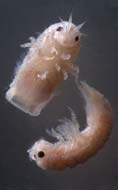 |
A team of British researchers has learned that gribble have a gift for digesting
wood not seen in any other organism. Enzymes produced by the tiny creatures are able to break down woody cellulose and turn it into energy-rich sugars. This excites scientists
investigating green fuel sources because it means gribble could hold the key to converting wood and straw into liquid biofuel. Via
Tywkiwdbi. What? Can't termites digest wood? All termites eat cellulose in its various forms as plant fibre. Cellulose is a rich energy source (as demonstrated by the amount of energy released
when wood is burned), but remains difficult to digest. Termites rely primarily upon symbiotic protozoa (metamonads) such as Trichonympha, and other microbes in their gut to digest the
cellulose for them and absorb the end products for their own use. Gut protozoa in turn rely on symbiotic bacteria embedded on their surfaces to produce some of the necessary digestive
enzymes. This relationship is one of the finest examples of mutualism among animals. Most so-called "higher termites", especially in the family Termitidae, can produce their own
cellulase enzymes. However, they still retain a rich gut fauna and primarily rely upon the bacteria. At right is the preserved specimen of fertile termite queen, showing her extended
abdomen. The rest of her body is the same size as that of a worker's. |
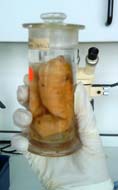 |
 |
The silliest questions as asked by users of the Any Questions Answered (AQA) text service:
Q: What’s the opposite of a camel?
A: The opposite of a camel is a soap dish; it has dimples instead of humps and lives in a mostly moist area.
Q: I want to write a film script which makes me millions. What should it be about?
A: Based on the top-grossing films, your script should be about a young wizard and a robot looking for a ring on a pirate ship which sinks. Good luck. |
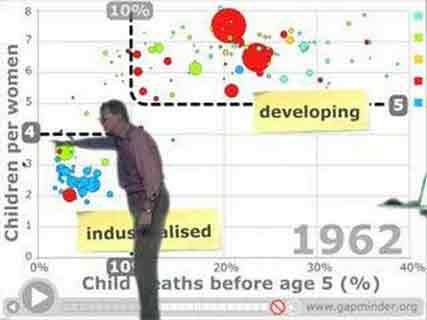
You've probably not seen data presented quite like
this. Statistics guru Hans Rosling, a professor of global health at Sweden's Karolinska Institute, focuses on dispelling common myths about the so-called developing world, which (he
points out with the drama and urgency of a sportscaster) is no longer worlds away from the west - in fact, most of the third world is on the same trajectory toward health and prosperity and many of
those countries are moving twice as fast as the west did. By any logic, a presentation that tracks global health and poverty trends should be, in a word: boring. But in Rosling's hands,
data sings. Trends come to life. And the big picture — usually hazy at best — snaps into sharp focus. He has developed visualisation software that really transforms data. Go
see his TED presentation - it's very worthwhile. Okay, it's 20 minutes long and you may think you just don't have time. Try playing with
this animated graph (note it has 2 tabs, "Chart" and "Map" or check out his
downloads. But everyone I know who has seen his presentation has been glad they did. |
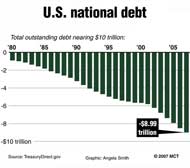 |
The Real Arithmetic of Health Care Reform: The US federal deficit is expected to exceed at least
$700 billion every year over the next decade, doubling the national debt to more than $20 trillion. By 2020, the federal deficit — the amount the government must borrow to meet its expenses — is
projected to be $1.2 trillion, $900 billion of which represents interest on previous debt. Wow. But what can they expect? There is no free lunch. |
 |
Only 3 countries - Burma, Liberia, and the United States - have yet to adopt the International System of Units as their official system of measurement (weights and measures). Although use of the
metric system has been sanctioned by law in the US since 1866, it has been slow in displacing the American adaptation of the British Imperial System known as the US Customary System. The US is the
only industrialised nation that does not mainly use the metric system in its commercial and standards activities, but there is increasing acceptance in science, medicine, government, and many sectors of
industry. The map on this site is interactive, with each country displaying the year they adopted the metric system. If you
care. |
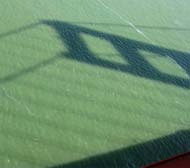 |
What is this? |
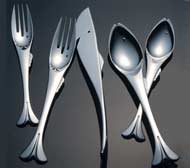 |
Creative and Unusual Cutlery Designs: It must be difficult designing something like cutlery
that has been designed so many times that coming up with something new is next to impossible. However, it CAN be done. These were my favourites. Via Presurfer. |
 |
|
|
 |
How to Be Persuasive:  People like to buy a
mid-range product. People like to buy a
mid-range product.  They are much more likely to believe a third party speaking about someone's accomplishments than
the person him or herself. They are much more likely to believe a third party speaking about someone's accomplishments than
the person him or herself.  Get people to write down a
goal. Get people to write down a
goal.  People are more likely to let someone break into a line for a copy machine if told "May I use the copy
machine, because I have to make copies" (a tautological reason). So use the powerful word "because" as much as
possible. People are more likely to let someone break into a line for a copy machine if told "May I use the copy
machine, because I have to make copies" (a tautological reason). So use the powerful word "because" as much as
possible.  Rhyming slogans and statements are more
powerful. Rhyming slogans and statements are more
powerful.  Colours and flavours are more appealing when they are puzzling. For example, "Kermit green" rather
than "green" or "millennium orange" rather than "orange" causes people to try to figure out what the names mean, prompting consumers to think of positive aspects of the
product. Colours and flavours are more appealing when they are puzzling. For example, "Kermit green" rather
than "green" or "millennium orange" rather than "orange" causes people to try to figure out what the names mean, prompting consumers to think of positive aspects of the
product.  Caffeine makes people more receptive to legitimately persuasive arguments about 40 minutes after a drink
is consumed. Caffeine makes people more receptive to legitimately persuasive arguments about 40 minutes after a drink
is consumed. |
 |
Physical appearance plays a crucial role in shaping new relationships, but does it continue to affect
established relationships, such as marriage? In contrast to the robust and almost universally positive effects of levels of attractiveness on new relationships, the only association between levels
of attractiveness and the outcomes of marriages was that attractive husbands tended to be less satisfied. Further, in contrast to the importance of matched attractiveness to new relationships,
similarity in attractiveness was unrelated to spouses' satisfaction and behaviour. Instead, the relative difference between partners' levels of attractiveness appeared to be most important in
predicting marital behaviour, such that both spouses behaved more positively in relationships in which the wives were more attractive than their husbands, but they behaved more negatively in
relationships in which husbands were more attractive than their wives. ("If you want to be happy for the rest of your life, always make a pretty woman your wife...") |
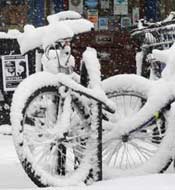 |
Software programs are now available to keep tabs on whether or not patients actually do what they are asked
to do. (How much intrusion is required to accomplish this was not specified.) This is an important issue because any treatment that involves home exercises or training depends on people
doing it. Historically, clinicians have used a training or home exercise diary to improve participation. Do they work? Or do patients just end up lying about it? Apparently, when
patients keep a diary, they indeed lie in it. Perhaps they don't knowingly lie – but they say they do more than they really do – they overestimate. They actually do more training when
they have a diary, so keeping one is a good thing overall. But when patients discovered that software programs recorded everything to be checked later, then they exercised even more but now
they UNDERestimate how much they did. |
 |
"Spin" enlivens non-stories; it sharpens an angle and manufactures difference. In his dialogue, The Decay of Lying, Wilde celebrates the artful lie, and laments its passing. His
complaint against politicians is not that they lie, but rather that they merely spin. Out of their mouths don't come real fabrications, but obfuscations. They misrepresent, and worse, then
seek proof and evidence for their claims. The true, brilliant, life-changing lie is something entirely different. It has complete disdain for the evidence, carried aloft by the sheer boldness
of its assertion. To reach such heights requires all the power of imagination and courage a human being can muster, along with a life's effort in training and skill. In short,
good lying nurtures a panoply of virtues. A great lie takes excellence. Spinning
and misrepresentation are mere skulduggery. Without lies there is no art, Wilde argues. It's not just that lying is an art, but that it is art itself. "[Liars] have their technique,
just as the more material arts of painting and sculpture have their subtle secrets of form and colour, their craft-mysteries, their deliberate artistic methods," Wilde suggests. Our problem, then,
is too strict an insistence on the truth. Relentlessly champion accuracy and you kill the imagination. Insist on proof at every turn and conversation becomes verification. The
"monstrous worship of facts" sucks the beauty from art and aborts pregnant possibilities. Without lying, there is no human interaction at all, just an exchange of data as if we were
machines. Truth is too big a price to pay for poor results.
Imagination is everything. It is the preview of life’s coming attractions. – Albert Einstein |
 |
 |
 |
 |
Page 1 position A4:
Kizhi, Karelia, Church of the Transfiguration (1714). These churches make wood do things I didn't realise it was able to do. |
Page 2 position B2:
Yandomozero, Karelia region, Church of St Barbara the Martyr (1650). This shows the technique for making perfect inside corners. |
Page 3 position A1:
Zachachye, Arkhangel region, Church of St. Nicholas (17th - 18th C). Though the roof needs repair, the outside walls joins are still perfect. |
Page 4 position A4:
Sholomya. Dark, but still has a feeling of sheltering souls from the dangers of the outside. |
|
Wooden Architecture of the Russian North: In 1911 The Society of the St Eugenia Community published
photographs of churches as a set of postcards sold to raise money to support its charitable work. Seeing these beautiful postcards inspired Londoner Richard Davies to travel repeatedly (beginning in
2002) to the Russian North to find out which churches had survived. Many churches have been lost: some have been left to rot, some destroyed by lightning, ignorance, spite, and neglect. But
many are still standing after hundreds of years. |
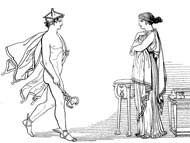 |
The name Calypso comes from the Greek kalupso, "I will conceal". On a 9 year-trip, Ulysses spends 7 years in captivity on Calypso’s island and she falls in love with him, entertains him, tries to
seduce him, tries to force his love. it doesn’t work - he isn’t interested. It takes a lot to bag him forever, and it would take even more to get him to love her in
return. Notwithstanding this lack of reciprocity and Ulysses’ bad graces, Calypso’s libido doesn’t fade or even plateau, she wants him badly. (Oh, he is SO handsome!) For his trip back
home, Ulysses will have to sail into crowded seas, lures, troubles, dangers, attacking freaks - he'll risk his life, getting into a lot of does-god-exist? kind of games. But on Calypso’s island,
he’s safe. This assured safety proves insufficient for Calypso to secure Ulysses’ love. Perhaps a bonus package will make it easier? Calypso stakes it all and offers him
immortality. She adds in eternal youth on top of abundant love, seaside dinners, star gazing, music (clearly Homer had access to decent MDMA). So: (1) Ulysses could stay young forever, but
he'd have to stay with Calypso forever, too, or (2) He could risk his life to go back home and reunite with his wife, Penelope. As soon as Ulysses gets back to Ithaca, he’ll be celebrated as a
hero, he’ll be worshipped (for his victory over Troy, the Trojan horse, et cetera). Being admired by a crowd is a strong plus. Now, draw a line in the
sand. immortality/mortality. In the current context, accepting immortality means staying on the island, which means being hidden from the world, "concealed" (hence Calypso’s name), which
equals being invincible and eternally young, maybe even sort of happy, but with nobody except Calypso knowing about it. It means being forgotten, ending up nobody. Goodbye hero’s
career - heroes’ exploits must be known in order to be praised. It starts to look like a really bad deal and so Ulysses refuses; he leaves. He chooses future death over being
immortal. What matters to him is being immortal in people’s minds, in books, in history, not just on that island, not only in Calypso’s
eyes. Understand this: celebrity is a drug. {Imp Kerr & Associates, NYC, 2009 - 2010 | background reading: Jean-Pierre,
Le Refus d’Ulysse [The Refusal of Odysseus], 1982}.
Maybe the guy above who was worried about his digital information not getting preserved for posterity was onto something important after all? |
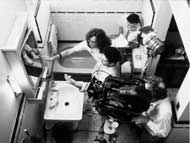 |
The Coen brothers (Joel and Ethan) are, in my opinion, insufficiently
appreciated. They are original and versatile and they seem able to draw forth inspired work from their cast and crew. While I like some of their movies more than others, there aren't any
that I just don't like at all. If you're unfamiliar with their work, try
starting here. And while I'm at it,
I'd like to also recommend practically any movie that has Roger Deakins as Director of Photography (cinematographer). He's worked
extensively with the Coen Brothers, so there'll be a lot of overlap. |
 |
Ever drop a book in the tub? Don't despair, you can save
it. Put it into a plastic bag (not a vacuum seal) and place in the freezer. The dehydration process, which keeps things cold, will pull the excess water out of the book. It takes
up to 2 weeks depending on the size of the book. If you have several items of approximately the same size — such as file folders — you can place them upright in a milk crate or box, separated
with paper towels, butcher paper, or waxed paper. If you're freezing books, stand them vertically on their spines. A milk crate is a good choice for this task because it allows air flow
around them. Pack the items just tight enough so that they remain upright. I spilled a large mug of tea into my file drawer shortly after I read this. I tried freezing the documents and it
worked quite well except a few were a bit wavy. I've heard paper can be ironed with a warm (not hot) iron and it's almost good as new but I haven't tried that yet. |
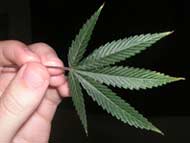 |
Little is known of the effects of cannabis, the world's most popular illicit drug. Cannabis smokers
often report that when stoned, their thoughts have a free-wheeling quality and concepts seem connected in unusual and playful ways. A study published online in Psychiatry Research suggests
that this effect may be due to the drug causing "fast and loose" patterns of spreading activity in memory, something known as hyper-priming. The researchers discuss the possibility that long-term
smokers who spend a lot of time in a chronic hyper-primed state might make psychosis more likely by loosening the boundaries of well-grounded thought, although exactly how cannabis raises the risk of
psychosis, and indeed, how exactly it affects the brain, is still not understood well enough to make a firm judgement. |
Speed, Quality, Cost: Pick Any Two
 Click on the buttons in the upper left-hand corner to change the lighting (NOT
on the picture!) Click on the buttons in the upper left-hand corner to change the lighting (NOT
on the picture!)

Cascaded Light Propagation Volumes for Real-Time Global Illumination
(from the SIGGRAPH Symposium on Interactive 3D Graphics and Games):
Light maps used in a game scene can be rendered at up to several hours per map, or light can be computed real-time.
Once, the difference in quality between the two was notable - today, not so much so.
At issue are realistic glossy reflections, indirect occlusions, multiple light bounces, and indirect lighting.
These things take time to compute and this can slow down a game's performance. These photos are taken from the presentation movie.
|
 |
My problems began after months and months of struggling with bills and banks and a mortgage
payment, when one of my more prosperous clients called and casually asked, "Did I invest $30,000 or $40,000 in the last bond issue you sold me?" Something like teeth gnawed at my
chest. "You mean you really don't remember?" "No. I've got so much going on I can't remember exactly. Besides, that's your job, right?" The teeth snapped hard. I became a crook,
endorsing cheques made out to the stock brokerage I worked for, putting the funds in my chequing account, trading heavily in stock options - always telling myself everyone would he paid off handsomely,
and no one would ever know. As my losses mounted in the option market, I created fraudulent securities, promising a higher return than real ones would ever pay. I took advantage of my
clients' trust and naiveté, and I stole their money. There was nothing very clever about what I was doing. I blame no addiction, no motor impulses, no uncontrollable cravings. I merely
deluded myself into believing that it was not immoral and that everything would turn out all right. When the Federal Reserve notified my bank of the huge sums going through my personal account, I
was finished. Boesky, Milken, Levine, the Keating Five — the 80's had its share of fraudulent money-changers. I'm not nearly in their league, nor would I want to be. But we're still
talking about lying and stealing and self-deceit. Prison was the fate of many of those crooked deal makers. I am one of them... |

The airliner abruptly stopped taxiing, turned around, and returned to the gate. After a long delay, it finally took off. A concerned passenger asked a flight attendant, "What
was the problem?"
"The pilot was worried by a noise he heard in one of the engines," he was told. "It took us a while to find a new pilot."
  
I find that the harder I work, the more luck I seem to have.
- Thomas Jefferson

For other updates click "Home" (for the latest) or "Next" (for older) below
|
 Animals
Animals Animation
Animation Art of Playing Cards
Art of Playing Cards Drugs
Drugs Education
Education Environment
Environment Flying
Flying History
History Humour
Humour Immigration
Immigration Info/Tech
Info/Tech Intellectual/Entertaining
Intellectual/Entertaining Lifestyles
Lifestyles Men
Men Money/Politics/Law
Money/Politics/Law New Jersey
New Jersey Odds and Oddities
Odds and Oddities Older & Under
Older & Under Photography
Photography Prisons
Prisons Relationships
Relationships Science
Science Social/Cultural
Social/Cultural Terrorism
Terrorism Wellington
Wellington Working
Working Zero Return Investment
Zero Return Investment









































